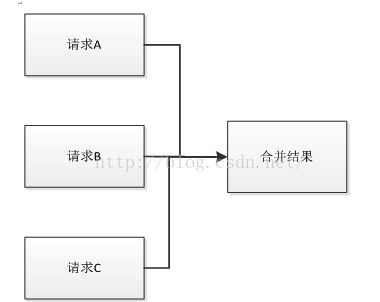聊聊java高并发系统之异步非阻塞
聊聊java高并发系统之异步非阻塞
几种调用方式
同步阻塞调用
即串行调用,响应时间为所有服务的响应时间总和;
半异步(异步Future)
线程池,异步Future,使用场景:并发请求多服务,总耗时为最长响应时间;提升总响应时间,但是阻塞主请求线程,高并发时依然会造成线程数过多,CPU上下文切换;
全异步(Callback)
Callback方式调用,使用场景:不考虑回调时间且只能对结果做简单处理,如果依赖服务是两个或两个以上服务,则不能合并两个服务的处理结果;不阻塞主请求线程,但使用场景有限。
异步回调链式编排
异步回调链式编排(JDK8 CompletableFuture),使用场景:其实不是异步调用方式,只是对依赖多服务的Callback调用结果处理做结果编排,来弥补Callback的不足,从而实现全异步链式调用。
接下来看看如何设计利用全异步Callback调用和异步回调链式编排处理结果来实现全异步系统设计。
同步阻塞调用:
public class Test {
public static void main(String[] args) throws Exception {
RpcService rpcService = new RpcService();
HttpService httpService = new HttpService();
//耗时10ms
Map result1 = rpcService.getRpcResult();
//耗时20ms
Integer result2 = httpService.getHttpResult();
//总耗时30ms
}
static class RpcService {
Map getRpcResult() throws Exception {
//调用远程方法(远程方法耗时约10ms,可以使用Thread.sleep模拟)
}
}
static class HttpService {
Integer getHttpResult() throws Exception {
//调用远程方法(远程方法耗时约20ms,可以使用Thread.sleep模拟)
Thread.sleep(20);
return 0;
}
}
}
public class Test {
final static ExecutorService executor = Executors.newFixedThreadPool(2);
public static void main(String[] args) {
RpcService rpcService = new RpcService();
HttpService httpService = new HttpService();
Future> future1 = null;
Future future2 = null;
try {
future1 = executor.submit(() -> rpcService.getRpcResult());
future2 = executor.submit(() -> httpService.getHttpResult());
//耗时10ms
Map result1 = future1.get(300, TimeUnit.MILLISECONDS);
//耗时20ms
Integer result2 = future2.get(300, TimeUnit.MILLISECONDS);
//总耗时20ms
} catch (Exception e) {
if (future1 != null) {
future1.cancel(true);
}
if (future2 != null) {
future2.cancel(true);
}
throw new RuntimeException(e);
}
}
static class RpcService {
Map getRpcResult() throws Exception {
//调用远程方法(远程方法耗时约10ms,可以使用Thread.sleep模拟)
}
}
static class HttpService {
Integer getHttpResult() throws Exception {
//调用远程方法(远程方法耗时约20ms,可以使用Thread.sleep模拟)
}
}
}
全异步(callback):
public class AsyncTest {
public staticHttpAsyncClient httpAsyncClient;
public static CompletableFuture getHttpData(String url) {
CompletableFuture asyncFuture = new CompletableFuture();
HttpPost post = new HttpPost(url);
HttpAsyncRequestProducer producer = HttpAsyncMethods.create(post);
AsyncCharConsumer consumer = newAsyncCharConsumer() {
HttpResponse response;
protected HttpResponse buildResult(final HttpContext context) {
return response;
}
…...
};
FutureCallback callback = new FutureCallback() {
public void completed(HttpResponse response) {
asyncFuture.complete(EntityUtils.toString(response.getEntity()));
}
…...
};
httpAsyncClient.execute(producer, consumer, callback);
return asyncFuture;
}
public static void main(String[] args) throws Exception {
AsyncTest.getHttpData("http://www.jd.com");
Thread.sleep(1000000);
}
}
异步回调链式编排:
CompletableFuture提供了50多个API,可以满足所需的各种场景的异步处理的编排,下面举一个场景:
三个服务并发异步调用,返回CompletableFuture,不阻塞主线程;
public static void test1() throws Exception {
HelloClientDemoTest service = new HelloClientDemoTest();
/**
* 场景1 两个以上服务并发异步调用,返回CompletableFuture,不阻塞主线程
* 并且两个服务也是异步非阻塞调用
*/
CompletableFuture future1 = service.getHttpData("http://www.jd.com");
CompletableFuture future2 = service.getHttpData("http://www.jd.com");
CompletableFuture future3 =service.getHttpData("http://www.jd.com");
List futureList = Lists.newArrayList(future1,future2, future3);
CompletableFuture allDoneFuture =CompletableFuture.allOf(futureList.toArray(newCompletableFuture[futureList.size()]));
CompletableFuture future4 =allDoneFuture.thenApply(v -> {
List result =futureList.stream().map(CompletableFuture::join)
.collect(Collectors.toList());
//注意顺序
String result1 = (String)result.get(0);
String result2 = (String)result.get(1);
String result3 = (String)result.get(2);
//处理业务....
return result1 + result2 + result3;
}).exceptionally(e -> {
//e.printStackTrace();
return "";
});
//返回
}